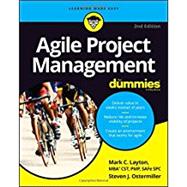Agile project management is a fast and flexible approach to managing all projects, not just software development. By learning the principles and techniques in this book, you'll be able to create a product roadmap, schedule projects, and prepare for product launches with the ease of Agile software developers. You'll discover how to manage scope, time, and cost, as well as team dynamics, quality, and risk of every project.
As mobile and web technologies continue to evolve rapidly, there is added pressure to develop and implement software projects in weeks instead of months—and Agile Project Management For Dummies can help you do just that. Providing a simple, step-by-step guide to Agile project management approaches, tools, and techniques, it shows product and project managers how to complete and implement projects more quickly than ever.
- Complete projects in weeks instead of months
- Reduce risk and leverage core benefits for projects
- Turn Agile theory into practice for all industries
- Effectively create an Agile environment
Get ready to grasp and apply Agile principles for faster, more accurate development.








